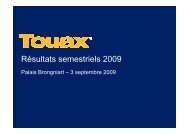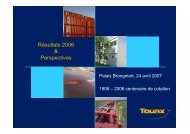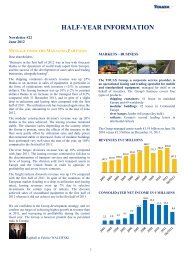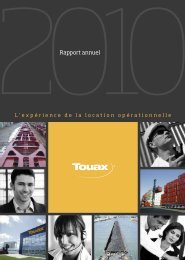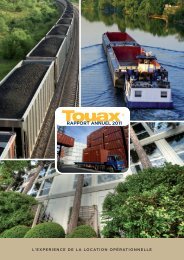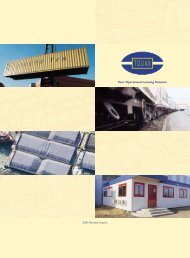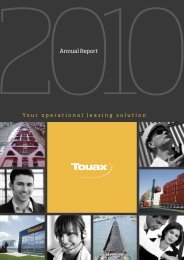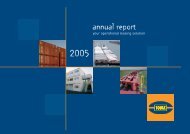2011 Annual report - touax group
2011 Annual report - touax group
2011 Annual report - touax group
Create successful ePaper yourself
Turn your PDF publications into a flip-book with our unique Google optimized e-Paper software.
<strong>Annual</strong> <strong>report</strong> <strong>2011</strong><br />
The theoretical maturity dates in <strong>2011</strong> are presented below:<br />
(€ millions)<br />
Repayment of medium/long-term credit 66.2<br />
Repayment of confirmed short-term credit with recourse 1.3<br />
Repayment of confirmed short-term credit without recourse 22.4<br />
Repayment of annual revolving credit 25.6<br />
TOTAL 115.6<br />
Estimated financial charges 20.0<br />
TOTAL 135.6<br />
At the end of December <strong>2011</strong>, the Group's balance sheet<br />
showed €44 million in cash and cash equivalents, over<br />
€77 million in available lines of credit to meet its cash<br />
requirements, and €69 million of assets in stock intended for<br />
sale to investors.<br />
The Group believes there is little risk of non-renewal of<br />
its short-term credit lines reaching maturity, and notes that<br />
the use of these revolving lines of credit depends on asset<br />
pre-financing needs, and therefore on the Group's investments<br />
or on temporarily including assets on its balance sheet.<br />
The <strong>group</strong> refinanced the OBSAR which matured on March 8,<br />
2012.<br />
A liquidity risk may arise if the Group cannot use the renewable<br />
credit facilities for financing assets due to its inability to meet<br />
the eligibility criteria that are conditions for using the credit<br />
lines.<br />
In the longer term, the liquidity risk resides in inappropriate<br />
matching of income generated by its leased assets with loan<br />
maturities.<br />
The timetable of dates when the Group’s debt falls due is as follows:<br />
(€ millions) TOTAL 2012 2013 2014 2015 2016 + 5 years<br />
Debts with recourse 265.7 93.5 26.6 26.9 21.9 69.6 27.2<br />
Debts without recourse 98.4 22.8 34.1 7.6 4.1 10.5 19.43<br />
TOTAL 364.1 116.3 60.7 34.5 26.0 80.1 46.5<br />
In general the Group’s liquidity risk is limited, thanks to its<br />
ability to sell or refinance its assets: The assets operated by the<br />
Group are standardized and low-tech; they keep relatively high<br />
residual values in a fairly liquid market.<br />
The Group faces three major types of counterparty risks:<br />
• cancellation of approved credit lines following the default of a<br />
lender,<br />
• counterparty default in the unwinding of an over-the-counter<br />
derivative,<br />
•non-repayment of cash surpluses invested in spot or futures<br />
markets with a financial institution or as part of an investment.<br />
The Group prefers financial relations with first-rate banks, i.e.<br />
institutions with excellent credit ratings from international<br />
credit rating agencies, for both renewable credit facilities and<br />
over-the-counter trading of hedging derivatives.<br />
The Group only invests its surpluses in non-dynamic monetary<br />
investment products with first-rate banks in spot or futures<br />
markets.<br />
Thus the Group believes it has little exposure to counterparty<br />
risk and does not use any derivatives to manage that risk.<br />
➜ Interest-rate risk<br />
The TOUAX Group relies on loans for both its development<br />
requirements and its investment policy. A large share of its loans<br />
apply a variable interest rate. Most of the Group's interest-rate<br />
risk is related to its variable interest-rate loans.<br />
In order to limit the negative impact of a rise in short-term rates,<br />
the Group's policy is to not speculate in interest rates. It uses plain<br />
vanilla derivatives, and negotiates new fixed-rate or variable rate<br />
loans according to its decision to modify the fixed rate-variable<br />
rate share of its debt.<br />
In order to limit the use of market transactions, the Group also<br />
strives to negotiate loans allowing modification of the indexing of<br />
interest from variable to fixed rates.<br />
In <strong>2011</strong>, the Group did not use any new interest-rate derivatives,<br />
since the hedging programme previously used, particularly in<br />
2009, made it possible to maintain the fixed rate debt at 49% of<br />
the overall long-term debt compared with 50% at the end of 2010.<br />
Long term fixed-rate debt represented 73% of total long-term<br />
debt, compared to 79% at the end of 2010.<br />
92



